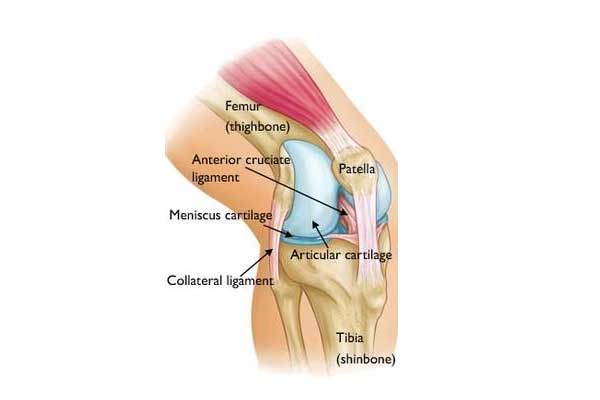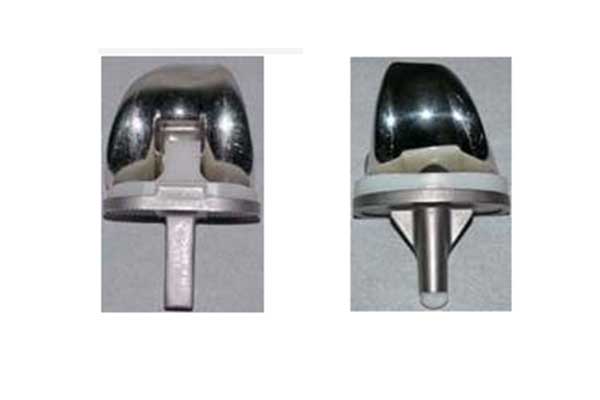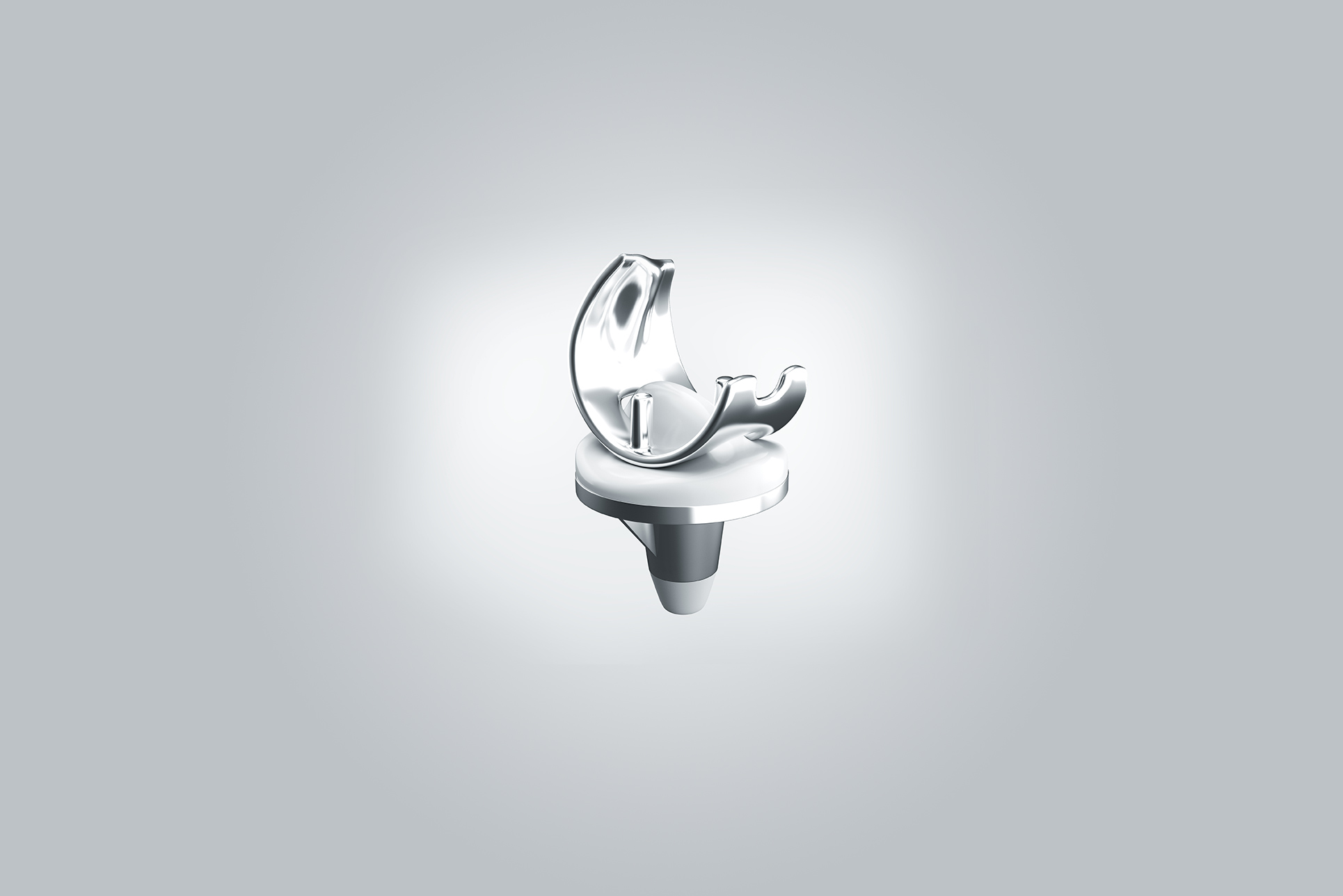IMPLANTS – PROSTHESES OF TOTAL KNEE ARTHROPLASTY
The orthopedic surgeon recommends knee replacement surgery when the patient feels severe pain, even at night, which cannot be treated with other means (medication, intraoperative), and there is restriction of movement due to osteoarthritis, rheumatoid arthritis or injury. The total knee arthroplasty is able to relieve pain and help the patient live a fuller and more active life.
With surgery, the knee articular surfaces are replaced with an artificial implant or “prosthesis”. Although replacement of the entire joint is the most common procedure, some patients benefit from partial replacement of the knee surfaces.
Implants are made of metal alloys (steel, titanium or cobalt), ceramic materials or strong plastics that are incorporated with the bone by using acrylic cement. There are many different types of implants. The surgeon should recommend the type of implant that best meets the patient’s needs.
Type of Implants – Prostheses (Implant Design)
Normal knee function
The knee is the largest and strongest joint in the body. It is composed of the lower end of the femur and the upper end of the tibia on which the thigh rests, carrying loads to the leg. The patella is located in front of the thigh and tibia providing protection to the joint and distributing the loads.
The knee, in normal conditions, allows flexion and extension of the lower leg as well as a limited degree of rotational movement. The knee joints stabilize and support the joint by avoiding extreme and dangerous leg positions that could lead to injury.
Basic Types of Implants – Prostheses
For the sake of simplicity, the knee is considered a “hinge” due to its ability to “open” and “close” like a door. In fact, the knee is a much more complicated joint, because the bone surfaces slide on each other as it bends and stretches.
The first types of implants used exploited the concept of the “hinge”-type joint and included a single bonded, articulated implant. The newer implants recognize the complexity of the joint and try to better mimic the movement of a normal knee. In some types of implants the patient’s ligaments are retained, while in others they are replaced by the prosthesis.
Today, a fairly large number of manufacturers produce more than 150 different types of prostheses available in the market. Recent developments in design include personalized implants for both sexes. Several studies have shown that the shape and proportions of a woman’s knee differ from those of a man’s knee. As a result, many manufacturers have developed special inserts (fittings) for implants that best fit the knee of the average man or woman. However, there are no studies to prove that such implants have a longer wear life or provide better function.

The right implant for the patient
The design and the manufacturing company of the implant used by the orthopedic surgeon depends on many factors, including the patient’s condition, needs (age, weight, activity level of activity and health), the physician’s experience and familiarity with the implant, as well as the estimated cost. All these issues should be analyzed and discussed with the treating physician.
Implant – Prosthesis Parts / Technical Specifications
Up to three bone surfaces are replaced in total knee arthroplasty:
Lower Femoral Bone – Femoral Prosthesis: The metallic element of the femoral prosthesis overlaps the distal part of the femur (thigh). It includes a groove that mimics the pulley in normal articulation and allows the patella to move smoothly during knee flexion and extension.
Upper Tibial Surface – Tibial Prosthesis: The tibial prosthesis consists of a flat metallic platform on which a separate insert of the most durable plastic is mounted, called polyethylene. In some designs the metallic part is omitted and the polyethylene insert is attached directly to the bone. For extra stability, the metallic part of the tibial prosthesis may also be comprised of a rod inserted deep into the center of the tibial bone, called a stylet.
The Articular Surface of the Patella – Patellar Prosthesis: Sometimes and depending on the wear, the articular surface of the patella is replaced by a special dome-shaped plastic (polyethylene) that reproduces the shape of the normal patella.
All parts of the implants have been designed so that the metallic surfaces are in contact with polyethylene, which minimizes friction and thus deterioration over time.

Posterior Stabilized Designs
In this type of prosthesis, the polyethylene of the tibial prosthesis has a raised surface with a specially shaped post (which corresponds to a specific line of the femoral component (cam). The posterior cruciate ligament is removed, so that the materials can be applied to the bone. In this way, the femoral and tibial prosthesis replace the function of the posterior cruciate ligament, preventing the thigh from over-sliding forwards when bending the knee.
Cruciate-Retaining Designs
As the name implies, in this type of prosthesis the posterior cruciate ligament is retained without the specific design described in the preceding paragraph. This type of prosthesis may be suitable for patients whose posterior cruciate ligaments are able to continue to stabilize the knee joint.
Unicompartimental Implants
In total knee arthroplasty, prostheses that overlap the extremities of the femur and tibia are used. If only one side of the knee joint is damaged, smaller implants may be used to overlap that side (Unicompartimental Knee Arthroplasty).


Implants with fixed or rotating polyethylene insert/(Fixed vs Mobile-bearing Prosthesis Implant)
Fixed Platform Prostheses: Most patients are implanted with a fixed polyethylene insert (fixed platform prostheses). In this type of prostheses, the polyethylene insert is firmly fastened to the metallic part of the tibia. In some cases, excessive activity or overweight can cause polyethylene to wear out faster. Worn-out materials can loosen implants and cause significant pain to the patient. Loosening of the prosthesis is one of the major causes of failure of total knee arthroplasty. In the event that patients are younger, more active or overweight, the Orthopedist may recommend a mobile rotating polyethylene insert (mobile platform prostheses). These implants are designed for potentially greater efficiency with less wear and tear.
Mobile Platform Prostheses: Mobile platform prostheses, like their fixed platform counterparts, use three different inserts to mimic a normal knee joint. However, in mobile platform prostheses, the polyethylene insert may rotate within narrower limits, relatively to the metallic tibia. This design allows patients a greater degree of rotation in their knee movements.
Compared to fixed platform prostheses, they require more support from soft tissues, such as knee joints. If the soft tissues are not strong enough, there is an increased chance of knee dislocation, a serious post-operative complication. In addition, mobile platform prostheses cost more. To date, there have been no studies that support greater resilience, better pain relief or knee function when using mobile platform prostheses.
Implant – Prostheses Materials
The metallic parts of the implant-prostheses consist of titanium or cobalt-chromium alloys. The plastic parts are made of ultra-high molecular weight polyethylene. Together they weigh 400-500 grams depending on the type and size of the prosthesis.
Specific Criteria on Construction Material
The construction materials used for prostheses must meet certain criteria:
- They must be biocompatible, without causing any reaction or rejection of the material after their application (rejection response).
- They must be able to faithfully reproduce the knee structures they are intended to replace. For example, they must be strong enough to withstand normal knee loads and flexible enough to withstand pressure. In addition, the prostheses must be able to slide smoothly on each other.
- They must be able to maintain their durability and shape for a long time.
Implants – Cemented and non-cemented prostheses
An additional difference between the prostheses lies in how they are stabilized on the bone.
In cemented prostheses a special resin is used – bone cement – with rapid polymerization (PMMA), which retains the implants by filling the gap between bone and implant.
The cementless prostheses are made of embossed or porous special material (e.g. hydroxyapatite). Firstly, the prostheses are pressed into the bone (press fit) and then a new bone is developed on the special surface of the implants.
The term “hybrid” refers to total knee arthroplasty surgeries, in which cementless femoral and tibial and/or patellar knee prostheses are used.
The orthopedic surgeon should carefully evaluate each case before deciding on the materials, technique and method of fixation and inform the patient adequately.
Total Arthroplasty Knee Revision Prostheses / (Revision Surgery)
The longevity and life span of an implant depends on several factors, including the level of activity, weight and overall condition of the patient.
Just as natural wear and tear contributes to the degeneration of normal joints, so the wear and tear of prosthetic materials may eventually require a second surgery called a revision surgery. Total knee arthroplasty revision surgeries often require specific prostheses that include longer rods for the tibia and thigh. In addition, metallic augments are attached to replace the possible bone defect that inevitably arises.
In many cases the revision prostheses make use of a posterior stabilized component for greater stability. In special cases of high instability or bone deficiency, it may be necessary to use a “hinged” prosthesis.


